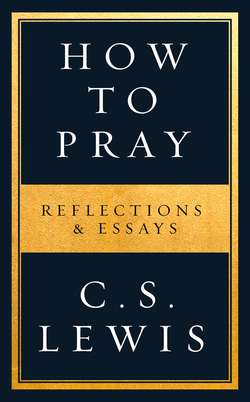Читать книгу How to Pray - Клайв Льюис, Клайв Стейплз Льюис, C. S. Lewis - Страница 6
ОглавлениеPREFACE
C. S. LEWIS is widely recognized as one of the twentieth century’s leading defenders and explainers of the Christian faith, especially through his classic works Mere Christianity, The Screwtape Letters, Miracles, The Problem of Pain, and more. What is ironic is that in private Lewis often expressed how his weakest moments were just after he had successfully defended a Christian idea or doctrine. What sustained him, though, was his commitment to living out what he saw as his ordinary Christian practices: attending church, practicing charity and hospitality, examining his motives and actions to lessen his weaknesses, confessing his sins, and strengthening what needed strengthening. And he prayed.
It is not surprising that a teacher of Christian faith would pray regularly, and it is easy to overlook the regular mentions of prayer in Lewis’s many letters over the years. “I will keep you in my prayers” sounds like a cliché, even though phrases like this appear often and regularly in his correspondence. Taken as a whole, these many references reveal something important: that Lewis took his practice of prayer seriously. If we are paying attention, it soon becomes apparent that Lewis routinely committed to praying for people, that he kept lists of such requests, tracking and updating them over time, that he had his own list of requests, that he often prayed traditional prayers from the prayer book as well as practicing many other forms of prayers besides making petitions, and he regularly dispensed advice on issues surrounding prayer. In his published work, the subject of prayer pops up regularly. In other words, Lewis spent a lot of time practicing, thinking about, and writing about prayer.
It is also clear that Lewis saw all this as wholly unremarkable. In a brief letter of August 1949, Lewis said to a friend, “I don’t feel I could write a book on Prayer: I think it would be rather ‘cheek’ of my part.” He obviously changed his mind in that he began writing such a book, though it was only published posthumously as Letters to Malcolm: Chiefly on Prayer. But even here, the emphasis is explaining how to think about prayer more than providing a primer on praying (though some of that leaks through).
By publishing this new volume entitled How to Pray, we are making the argument that what Lewis saw as unremarkable is still remarkably important. By reading the pieces included here, it becomes clear that it was Lewis’s long-term commitment to the practice of prayer that helps explain why his teachings have such depth and vibrancy even after many decades. Lewis never reduces the faith to mere intellectual or philosophical problems. Instead, his apologetic work was merely one dimension of what he experienced as a much larger reality, a reality grounded in a relationship with the living God. Even issues regarding prayer are presented within the larger frame of this relational foundation.
In How to Pray, we have tried to gather Lewis’s wisdom on prayer sprinkled throughout his books, essays, letters, and poems—all of which appear within this volume. And because Lewis wrote as a lifelong practitioner of prayer, what he says is often wise, striking, and deep, which will not be a surprise to anyone who has looked to Lewis as a Christian guide and mentor before. For the sake of consistency and cohesion, we have retitled the pieces in the form of questions about prayer that the pieces could be said to answer. The pieces’ original titles and sources are listed on the opening page of each chapter and at the end of the book. In each of the chapters, you will also find shorter excerpts on the topic as sidebars. We are indebted to and thankful for the thorough work of Zachary Kincaid, who researched and selected these pieces. Our hope in presenting this volume is that people will not only celebrate Lewis for what he said about Christianity but also for how he lived as a Christian. I hope by the end of the book you will say amen to that.
MICHAEL G. MAUDLIN
Senior vice president and executive editor
HarperOne
